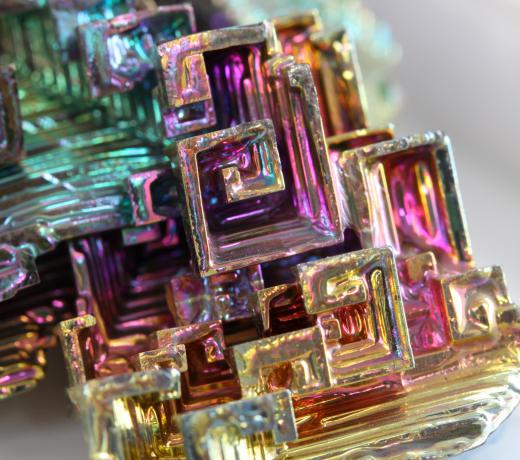What is Polonium?
 Mary McMahon
Mary McMahon
Polonium is an extremely unstable radioactive chemical element which forms as part of the decay process of radium, another radioactive element. Because polonium is a stage in radium's decay process, it is sometimes called radium F. This element appears in trace amounts in nature, typically in uranium ores, and most of its uses are in theoretical physics. It does have some industrial uses, but because of its radioactivity, consumers are unlikely to encounter it.
The instability of this element makes it difficult for scientists to identify its chemical properties. It takes on a solid shape in pure form, and appears to have a crystalline physical structure. It is typically classified as a metalloid, and as one might imagine, it is highly toxic due to its radioactivity. Given the rarity of polonium, you are unlikely to encounter it; if you see enough to be able to be able to examine its physical properties, you will be dead from radiation exposure. On the periodic table of elements, you can find polonium under Po, and it has an atomic number of 84.

The discovery of polonium is credited to Marie Curie, who named it for her native Poland in 1898. Intriguingly, polonium's name is actually rooted in political protest; Poland did not exist as an independent nation at the time, and Curie wanted to draw attention to Poland's plight. Ultimately, Poland became independent in 1918, only to be annexed by Russia during the Communist era. Curie received not one but two Nobel prizes for her work on polonium and radium, one in 1903 and another in 1911. Her contributions to science are immortalized in the element curium and in the Curie, a unit of radiation.

In laboratories, polonium is used as a source of neutrons for experiments. It can be produced by bombarding a bismuth isotope with alpha particles; polonium produced through this practice is also used in nuclear reactors. The element also appears in some devices which are designed to reduce or eliminate static, and it is sometimes used in the manufacture of spark plugs, as well. Polonium has 34 isotopes, all of which happen to be radioactive as well.

This element is extremely toxic; exposure to a surprisingly small amount can be deadly. As a result, the people who work with polonium are very careful around it to minimize their exposure. The naturally occurring polonium in the Earth is not generally deemed to be dangerous, since the element is so rare and it contributes a very small amount of background radiation. However, since the element concentrates in several vital organs, it is important to monitor lifetime exposure for scientists who may be at risk of poisoning.
AS FEATURED ON:
AS FEATURED ON:













Discuss this Article
Post your comments